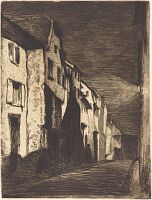Etchings Institutions search term: grolier club
Street at Saverne | ||
| Number: | 14 | |
| Date: | 1858 | |
| Medium: | etching and open bite or sandpaper ground | |
| Size: | 209 x 159 mm | |
| Signed: | 'Whistler' at lower left | |
| Inscribed: | 'Imp. Delatre. Rue St. Jacques' at lower right (2-3); erased (4) | |
| Set/Publication: | 'French Set', 1858 | |
| No. of States: | 4 | |
| Known impressions: | 81 | |
| Catalogues: | K.19; M.19; T.7; W.11 | |
| Impressions taken from this plate (81) | ||
KEYWORD
TITLE
'Street at Saverne' (1858, Whistler). 2
'Saverne - night' (1874, Whistler). 3
'Street at Saverne – Night' (1874, James Anderson Rose (1819-1890)). 4
'Street at Saverne' (1874, Ralph Thomas, Jr (1840-1876)). 5
'Saverne' (1870s, Whistler).. 6
'Street at Saverne' is the original and generally accepted title. The later impressions undoubtedly show it as a night scene, but clearly Whistler's first intention was to specify the place, not the time.
By the 1870s he was beginning to use the title 'Nocturne' but although this was his first night scene it was never called 'Nocturne'. The first etchings to be given that title were in Venice in 1879/1880, in, for instance, Nocturne: Palaces [200].
2: Douze eaux-fortes d'après Nature.
3: London Pall Mall 1874 (cat. no. 5).
4: Liverpool 1874 (cat. no. 506).
5: Thomas 1874 (cat. no. 7).
DESCRIPTION
SITE
DISCUSSION
No works by Whistler have been found in the museum at Saverne.
7: Pennell 1911 A , p. 43.


